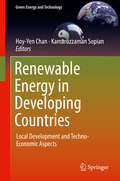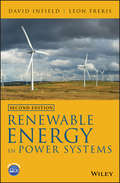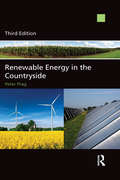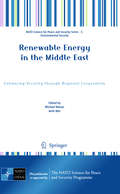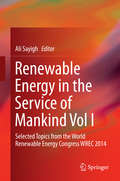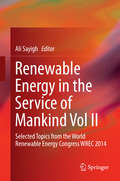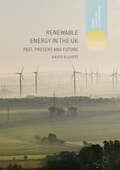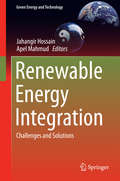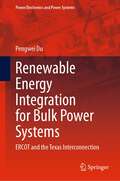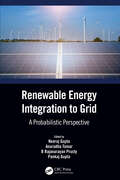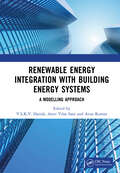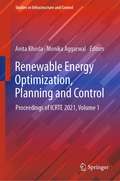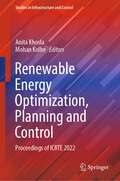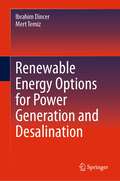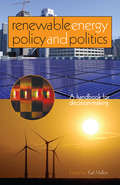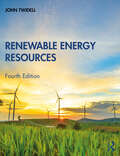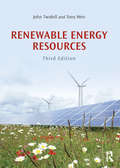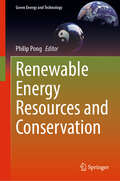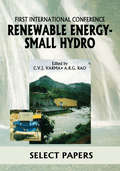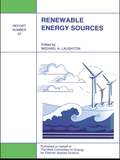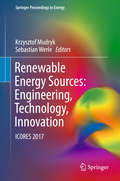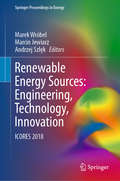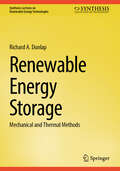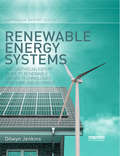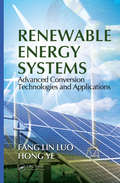- Table View
- List View
Renewable Energy in Developing Countries: Local Development And Techno-economic (Green Energy and Technology)
by Hoy-Yen Chan Kamaruzzaman SopianThis book discusses aspects of policy and techno-economic analysis of renewable energy in developing countries. Renewable energy technologies have been one of the most important strategies in addressing sustainable energy development and climate change. The roles of renewable energy in developing countries are vital, which include the accessibility of modern energy services in rural areas, climate change mitigation, energy security, green job creation and eventually improvement of quality of life. Part I of this book focuses on policy and strategy, while Part II focuses on technology development and feasibility. Chapters are contributed by leading experts from the ASEAN Center of Energy, government agencies, industries, and universities from five developing countries, including Malaysia, Indonesia, Vietnam, Brunei Darussalam and Bangladesh.
Renewable Energy in Power Systems
by David Infield Leon FrerisAn up to date account of renewable sources of electricity generation and their integration into power systems With the growth in installed capacity of renewable energy (RE) generation, many countries such as the UK are relying on higher levels of RE generation to meet targets for reduced greenhouse gas emissions. In the face of this, the integration issue is now of increasing concern, in particular to system operators. This updated text describes the individual renewable technologies and their power generation characteristics alongside an expanded introduction to power systems and the challenges posed by high levels of penetrations from such technologies, together with an account of technologies and changes to system operation that can ease RE integration. Features of this edition: Covers power conditioning, the characteristics of RE generators, with emphasis on their time varying nature, and the use of power electronics in interfacing RE sources to grids Outlines up to date RE integration issues such as power flow in networks supplied from a combination of conventional and renewable energy sources Updated coverage of the economics of power generation and the role of markets in delivering investment in sustainable solutions Considers the challenge of maintaining power balance in a system with increasing RE input, including recent moves toward power system frequency support from RE sources Offers an insightful perspective on the shape of future power systems including offshore networks and demand side management Includes worked examples that enhance this edition’s suitability as a textbook for introductory courses in RE systems technology Firmly established as an essential reference, the Second Edition of Renewable Energy in Power Systems will prove a real asset to engineers and others involved in both the traditional power and fast growing renewables sector. This text should also be of particular benefit to students of electrical power engineering and will additionally appeal to non-specialists through the inclusion of background material covering the basics of electricity generation.
Renewable Energy in the Countryside
by Peter PragClimate change has become a major international issue and the British Government is committed to meeting ambitious targets for reducing greenhouse gas emissions within the present decade and beyond. Much of this will rely on an increasing use of renewable energy. Within current technology this will depend almost exclusively upon the use of rural land, whether for wind turbines, for growing biomass and biofuels or for the production of biogas. Renewable energy is therefore of immediate interest to farmers and landowners and to their advisers, such as surveyors, lawyers, accountants and bankers, as well as to planners and conservationists. This is one of very few books which addresses the issue of renewable energy from the point of view of landowners, farmers and rural land managers – those people who must make important decisions about how, where and when to install renewable energy sources on their land and the business implications of the decisions they make. The third edition of Renewable Energy in the Countryside contains a new chapter on biogas, up-to-date discussions on the implications of the Renewable Heat Initiative and new opportunities for solar energy and ground source heat in the context of farms and country houses as well as the implications of changes in UK planning policies.
Renewable Energy in the Middle East
by Michael Mason Amit MorEnergy insecurity is not normally associated with the Middle East. However, away from the oil-rich Persian Gulf, the countries of the eastern Mediterranean are particularly vulnerable. Their fossil fuel endowments are low, while their fractious relationships with each other have long fostered wider political insecurities. Focusing on the Jordan Basin (Israel, the Palestinian Territories, Lebanon and Jordan), this timely volume addresses the prospects for the adoption of renewable energy in the oil-poor Middle East. Featuring regional energy experts, it offers an invaluable survey. After outlining the regional security context, this book first reviews renewable energy policy and practices in the Jordan Basin. It then considers options for greening energy use, including promising pilot projects in North Africa. The initiatives discussed encompass renewable energy finance, energy-efficient rural communities, and solar and wind energy. There is significant potential for an increase in the uptake of renewable energy technologies in the eastern Mediterranean. This window of opportunity has been created by high oil prices, energy infrastructure investment opportunities, and the UN climate change regime. In conclusion, the book considers the institutional conditions for collaborative decision-making on renewable energy. Such cooperation would deliver substantial security and human development benefits to the region, and indeed the world.
Renewable Energy in the Service of Mankind Vol I
by Ali SayighThis book provides insights on a broad spectrum of renewable and sustainable energy technologies from the world's leading experts. It highlights the latest achievements in policy, research and applications, keeping readers up-to-date on progress in this rapidly advancing field. Detailed studies of technological breakthroughs and optimizations are contextualized with in-depth examinations of experimental and industrial installations, connecting lab innovations to success in the field. The volume contains selected papers presented at technical and plenary sessions at the World Renewable Energy Congress, the world's premier conference on renewable energy and sustainable development. Held every two years, the Congress provides an international forum that attracts hundreds of delegates from more than 60 countries.
Renewable Energy in the Service of Mankind Vol II
by Ali SayighThis book provides insights on a broad spectrum of renewable and sustainable energy technologies from the world's leading experts. It highlights the latest achievements in policy, research and applications, keeping readers up-to-date on progress in this rapidly advancing field. Detailed studies of technological breakthroughs and optimizations are contextualized with in-depth examinations of experimental and industrial installations, connecting lab innovations to success in the field. The volume contains selected papers presented at technical and plenary sessions at the World Renewable Energy Congress, the world's premier conference on renewable energy and sustainable development. Held every two years, the Congress provides an international forum that attracts hundreds of delegates from more than 60 countries.
Renewable Energy in the UK: Past, Present and Future (Energy, Climate and the Environment)
by David ElliottThis book offers a detailed account of how renewable energy has moved from the margins to the mainstream in the UK, and of the battles that have been fought to achieve this, trawling through the often troubled history of government involvement. The book examines how renewables became what now seem likely to be the dominant energy sources of the future. Renewable energy technologies, using solar and wind power and other natural energy sources, are now supplying around 30% of UK electricity and appear set to continue expanding to supply around 50% within the next decade. Although the emphasis of the book is on the UK, developments there are compared with those in other countries to provide an overall assessment of the relevance of the UK experience. Chapters explore why the UK still lags behind many other countries in deploying renewables, in part, it is argued, due to its continued reliance on nuclear power. The book ends with a discussion on what sort of changes may be expected over the coming years. The author does not assume a single answer, but invites readers to consider the possibilities.
Renewable Energy Integration
by Jahangir Hossain Apel MahmudThis book presents different aspects of renewable energy integration, from the latest developments in renewable energy technologies to the currently growing smart grids. The importance of different renewable energy sources is discussed, in order to identify the advantages and challenges for each technology. The rules of connecting the renewable energy sources have also been covered along with practical examples. Since solar and wind energy are the most popular forms of renewable energy sources, this book provides the challenges of integrating these renewable generators along with some innovative solutions. As the complexity of power system operation has been raised due to the renewable energy integration, this book also includes some analysis to investigate the characteristics of power systems in a smarter way. This book is intended for those working in the area of renewable energy integration in distribution networks.
Renewable Energy Integration for Bulk Power Systems: ERCOT and the Texas Interconnection (Power Electronics and Power Systems)
by Pengwei DuRenewable Energy Integration for Bulk Power Systems: ERCOT and the Texas Interconnection looks at the practices and changes introduced in the Texas electric grid to facilitate renewable energy integration. It offers an informed perspective on solutions that have been successfully demonstrated, tested, and validated by the Electric Reliability Council of Texas (ERCOT) to meet the key challenges which engineers face in integrating increased levels of renewable resources into existing electric grids while maintaining reliability. Coverage includes renewable forecasting, ancillary services, and grid and market operations. Proved methods and their particular use scenarios, including wind, solar, and other resources like batteries and demand response, are also covered. The book focuses on a real-world context that will help practicing engineers, utility providers, and researchers understand the practical considerations for developing renewable integration solutions and inspire the future development of more innovative strategies and theoretical underpinnings.
Renewable Energy Integration to the Grid: A Probabilistic Perspective
by Neeraj GuptaThis comprehensive reference text discusses uncertainty modeling of renewable energy resources and its steady state analysis. The text discusses challenges related to renewable energy integration to the grid, techniques to mitigate these challenges, problems associated with integration at transmission and distribution voltage level, and protection of power system with large renewable power integration. It covers important concepts including voltage issues in power networks, use of FACTS devices for reactive power management, stochastic optimization, robust optimization, and spatiotemporal dependence modeling. Key Features: Presents analysis and modeling of renewable generation uncertainty for planning and operation, beneficial for industry professionals and researchers. Discusses dependence modeling of multi-site renewable generations in detail. Covers probabilistic analysis, useful for data analysts. Discusses various aspects of renewable energy integration i.e. technical, economic, etc. Covers correlation factors, and methodologies are validated with case studies with various standard test systems. The text will be useful for graduate students and professionals in the fields of electrical engineering, electronics and communication engineering, renewable energy, and clean technologies.
Renewable Energy Integration with Building Energy Systems: A Modelling Approach
by Harish, V.S.K.V.Construction as an industry sector is responsible for around one-third of the total world-wide energy usage, and about 20% of greenhouse gas emissions. The rise in number of buildings and floor space area for both residential and commercial purposes has imposed enormous pressure on existing sources of energy. Implementations like efficient usage of building energy systems, design measures, utilization of local energy resources, energy storage and renewable energy sources for meeting electricity demand are currently under development and deployment to improve the energy performance index. However, integrating all such measures and evaluation of developed nearly zero-energy and zero-emission buildings is yet to be explored. In this book, different control techniques together with intelligent building technology used to improve the energy performance of buildings have been illustrated. Every building energy control system has a two-fold objective for energy and comfort requirements to achieve a high comfort index (for thermal, visual, air quality, humidity and various plug loads) and to increase the energy performance index. The most significant aspect of the design of buildings’ energy control system is modelling. All the components, methodologies and processes involved in developing a renewable energy-driven building are covered in detail. This book is intended for graduates and professionals working towards the development of sustainable built environment using renewable energy sources.
Renewable Energy Optimization, Planning and Control: Proceedings of ICRTE 2021, Volume 1 (Studies in Infrastructure and Control)
by Anita Khosla Monika AggarwalThis book gathers selected high-quality research papers presented at International Conference on Renewable Technologies in Engineering (ICRTE 2021) organized by Manav Rachna International Institute of Research & Studies, Faridabad, Haryana, India, during 15–16 April 2021. The book includes conference papers on the theme “Computational Techniques for Renewable Energy Optimization”, which aims to bring together leading academic scientists, researchers and research scholars to exchange and share their experiences and research results on all aspects of renewable energy integration, planning, control and optimization. It also provides a premier interdisciplinary platform for researchers, practitioners and educators to present and discuss the most recent innovations, trends and concerns as well as practical challenges encountered and solutions adopted in the fields of renewable energy and resources.
Renewable Energy Optimization, Planning and Control: Proceedings of ICRTE 2022 (Studies in Infrastructure and Control)
by Anita Khosla Mohan KolheThis book gathers selected high-quality research papers presented at International Conference on Renewable Technologies in Engineering (ICRTE 2022) organized by Manav Rachna International Institute of Research & Studies, Faridabad, Haryana, India, during October 7–8, 2022. The book includes conference papers on the theme ‘Computational Techniques for Renewable Energy Optimization,’ which aims to bring together leading academic scientists, researchers, and research scholars to exchange and share their experiences and research results on all aspects of renewable energy integration, planning, control, and optimization. It also provides a premier interdisciplinary platform for researchers, practitioners, and educators to present and discuss the most recent innovations, trends, and concerns as well as practical challenges encountered and solutions adopted in the fields of renewable energy and resources.
Renewable Energy Options for Power Generation and Desalination
by Ibrahim Dincer Mert TemizThis book examines simultaneous power generation and desalination driven by renewable energy systems. It covers all renewables, including solar, wind, geothermal, hydro, ocean and biomass as well as waste sources. This book also includes thermodynamic fundamentals, concepts, and system design, analysis and assessment studies, along with illustrative examples and case studies, for sustainable applications. It further provides an ample opportunity to learn more about cutting-edge technologies and newly developed systems for power generation and desalination.
Renewable Energy Policy and Politics: A handbook for decision-making
by Karl MallonUnderstanding why renewable energy policies succeed and fail is essential for a range of stakeholders in the energy and environmental sectors. Clear information on why and how to secure successful renewable energy markets is much needed. Renewable Energy Policy and Politics meets that need, bringing together the experience of world leaders in this field. The book addresses the politics of renewable energy, the key players required to drive energy reform and those likely to resist change. The interplay between government, industry and society is discussed and explained with a balanced hand, offering a rare insight into political campaigning on energy. International case studies are included, complemented by a step-by-step breakdown of the elements required to achieve legislation. This book sets out the rules of the game, the stakes and the strategies for success. It will be an invaluable tool for policy makers, energy consultants, non-governmental organizations and other professionals working in the fields of energy policy, climate change and environmental policy. Students and researchers keen to enhance their knowledge of renewable energy markets and policy development will also find this essential reading.
Renewable Energy Resources
by John TwidellRenewable Energy Resources is a numerate and quantitative text. It covers the many renewables technologies implemented worldwide by harnessing sustainable resources, mitigating pollution and climate change, and providing cost effective services. This fourth edition is extensively updated by John Twidell with global developments as underpinned by fundamental analysis and illustrated by case studies and worked examples. Efficiency of end-use and cost-effectiveness is emphasized. Each chapter begins with fundamental scientific theory, and then considers applications, environmental impact and socio-economic aspects, before concluding with Quick Questions for self-revision, Problems and new Exercises. Basic theory underlying the technologies is covered in succinct Reviews of electrical power, fluid dynamics, heat transfer and solid-state physics. Common symbols and cross-referencing apply throughout; essential data are tabulated in Appendices. Renewable Energy Resources supports multidisciplinary master’s degrees in science and engineering, and specialist modules at undergraduate level. Practicing scientists and engineers will find it a useful introductory text and reference book.
Renewable Energy Resources
by John Twidell Tony WeirRenewable Energy Resources is a numerate and quantitative text covering the full range of renewable energy technologies and their implementation worldwide. Energy supplies from renewables (such as from biofuels, solar heat, photovoltaics, wind, hydro, wave, tidal, geothermal, and ocean-thermal) are essential components of every nation’s energy strategy, not least because of concerns for the local and global environment, for energy security and for sustainability. Thus in the years between the first and this third edition, most renewable energy technologies have grown from fledgling impact to significant importance because they make good sense, good policy and good business. This Third Edition is extensively updated in light of these developments, while maintaining the book’s emphasis on fundamentals, complemented by analysis of applications. Renewable energy helps secure national resources, mitigates pollution and climate change, and provides cost effective services. These benefits are analysed and illustrated with case studies and worked examples. The book recognises the importance of cost effectiveness and efficiency of end-use. Each chapter begins with fundamental scientific theory, and then considers applications, environmental impact and socio-economic aspects before concluding with Quick Questions for self-revision and Set Problems. The book includes Reviews of basic theory underlying renewable energy technologies, such as electrical power, fluid dynamics, heat transfer and solid-state physics. Common symbols and cross-referencing apply throughout; essential data are tabulated in appendices. An associated eResource provides supplementary material on particular topics, plus a solutions guide to Set Problems. Renewable Energy Resources supports multi-disciplinary master degrees in science and engineering, and specialist modules in first degrees. Practising scientists and engineers who have not had a comprehensive training in renewable energy will find it a useful introductory text and a reference book.
Renewable Energy Resources and Conservation (Green Energy and Technology)
by Philip PongThis book offers a comprehensive overview of state-of-the-art research and development in diverse areas of renewable energy, including renewable energy storage, conservation, solar, wind, biomass, nuclear, geothermal, and renewable energy systems. It is a valuable resource for anyone interested in gaining insight into the latest advancements in renewable energy technologies and their applications. The book chapters present selected high-quality research from the 8th International Conference on Renewable Energy and Conservation (ICREC 2023) that analyze the latest trends and present case studies. Renewable Energy Resources and Conservation offers researchers, practitioners, professionals, and scientists working in renewable energy engineering a host of authoritative ideas and insights into renewable energy grid infrastructures, engineering design methods, technologies, and best practices to address industrial challenges.
Renewable Energy - Small Hydro
by C.V.J. Varma and A.R.G. RaoThis is a collection of conference papers on small hydro renewable energy, covering such topics as: resource assessment and planning; design and construction; and plant and equipment.
Renewable Energy Sources: Watt Committee: report number 22
by Michael A. LaughtonPresents and analyses the sources of renewable energy, including advantages and disadvantages, projects implemented internationally, cost and environmental implications, and the benefits of system integration.
Renewable Energy Sources: Icores 2017 (Springer Proceedings in Energy)
by Sebastian Werle Krzysztof MudrykThis volume presents refereed papers based on the oral and poster presentations at the 4th International Conference on Renewable Energy Sources, which was held from June 20 to 23, 2017 in Krynica, Poland. The scope of the conference included a wide range of topics in renewable energy technology, with a major focus on biomass and solar energy, but also extending to geothermal energy, heat pumps, fuel cells, wind energy, energy storage, and the modeling and optimization of renewable energy systems. The conference had the unique goal of gathering Polish and international researchers’ perspectives on renewable energy sources, and furthermore of balancing them against governmental policy considerations. Accordingly, the conference offered not only scientific sessions but also panels to discuss best practices and solutions with local entrepreneurs and federal government bodies. The Conference was jointly organized by the University of Agriculture in Krakow, the International Commission of Agricultural and Biosystems Engineering (CIGR), the Polish Society of Agricultural Engineering, AGH University of Science and Technology (Krakow), the Polish Society for Agrophysics under the patronage of the Rector of the University of Agriculture in Krakow, and the Polish Chamber of Ecology.
Renewable Energy Sources: ICORES 2018 (Springer Proceedings in Energy)
by Marek Wróbel Marcin Jewiarz Andrzej SzlękThis book presents peer-reviewed papers based on the oral and poster presentations during the 5th International Conference on Renewable Energy Sources, which was held from June 20 to 22, 2018 in Krynica, Poland. The scope of the conference included a wide range of topics in renewable energy technology, with a major focus on biomass, solar energy and geothermal energy, but also extending to heat pumps, fuel cells, wind energy, energy storage, and the modelling and optimization of renewable energy systems. This edition of the conference had a special focus on the role of renewable energy in the reduction of air pollution in the Eastern European region.Traditionally this conference is a unique occasion for gathering Polish and international researchers’ perspectives on renewable energy sources, and furthermore of balancing them against governmental policy considerations. Accordingly, the conference offered also panels to discuss best practices and solutions with local entrepreneurs and federal government bodies. The meeting attracts not only scientist but also industry representatives as well as local and federal government personnel. In 2018, the conference was organized by the University of Agriculture in Krakow in cooperation with AGH University of Science and Technology (Krakow), University of Žilina, Silesian University of Technology, International Commission of Agricultural and Biosystems Engineering (CIGR) and Polish Society of Agricultural Engineering. Honorary auspices were given by the Ministry of Science and Higher Education Republic of Poland, Rector of the University of Agriculture in Krakow and Rector of the AGH University of Science and Technology.
Renewable Energy Storage: Mechanical and Thermal Methods (Synthesis Lectures on Renewable Energy Technologies)
by Richard A. DunlapEnergy use is not uniform throughout the day and year. Renewable energy resources such as hydroelectric, wind, and solar energy, generate different amounts of energy over time and space, and are not always available when and where they are needed. A storage mechanism is often required to allow generated energy to be utilized effectively. This book reviews some of the important technologies for energy storage that utilize mechanical methods and thermal methods. In the first part of the book, mechanical energy storage methods are considered. These methods include pumped hydroelectric energy storage, gravitational potential of solid masses, and flywheels. In the second part, various methods of storing thermal energy are discussed. These include the use of the sensible heat of materials, the latent heat associated with phase transitions, and heat associated with chemical reactions.
Renewable Energy Systems: The Earthscan Expert Guide to Renewable Energy Technologies for Home and Business (Earthscan Expert)
by Dilwyn JenkinsThis book is the long awaited guide for anyone interested in renewables at home or work. It sweeps away scores of common misconceptions while clearly illustrating the best in renewable and energy efficiency technologies. A fully illustrated guide to renewable energy for the home and small business, the book provides an expert overview of precisely which sustainable energy technologies are appropriate for wide-spread domestic and small business application. The sections on different renewable energy options provide detailed descriptions of each technology along with case studies, installation diagrams and colour photographs, showing precisely what is possible for the average household. The chapter on how to select the renewable technology most appropriate for ordinary homes and businesses summarizes this analysis in a neat and easy to use table and demonstrates with examples exactly how to assess your local renewable resources. Renewable technologies covered include wood energy, wind power, solar photovoltaics, solar thermal, passive solar, geothermal and air-to-air heat pumps as well as water or hydro based energy systems – plus the all-important subject of energy efficiency. Whilst written to be accessible to a wide audience, the book is targeted at readers who are keen to work with renewable technologies, students, building engineers, architects, planners, householders and home-owners.
Renewable Energy Systems: Advanced Conversion Technologies and Applications (Industrial Electronics)
by Fang Lin Luo Ye HongEnergy conversion techniques are key in power electronics and even more so in renewable energy source systems, which require a large number of converters. Renewable Energy Systems: Advanced Conversion Technologies and Applications describes advanced conversion technologies and provides design examples of converters and inverters for renewable energy systems—including wind turbine and solar panel energy systems. Learn Cutting-Edge Techniques for Converters and Inverters Setting the scene, the book begins with a review of the basics of astronomy and Earth physics. It then systematically introduces more than 200 topologies of advanced converters originally developed by the authors, including 150 updated circuits on modern conversion technologies. It also discusses recently published topologies and thoroughly analyzes new converter circuits. Novel approaches include split-capacitor and split-inductor techniques that can be applied in super-lift and other converters. Resolve Historic Problems in Conversion Technologies Along with offering many cutting-edge techniques, the authors resolve some historic problems, such as the accurate determination of the conduction angle of single-phase rectifiers and power factor correction. They also describe a new series—laddered multilevel inverters—that uses few devices to produce more levels, overcoming the drawbacks of the pulse-width-modulation (PWM) inverter and providing great scope for industrial applications. Tap the Knowledge of Pioneers in the Field This book is written by pioneers in advanced conversion technology who have created a large number of converters, including the world-renowned DC/DC Luo-converters and super-lift Luo-converters. Featuring numerous examples and diagrams, it guides readers in designing advanced converters for use in renewable energy systems.
